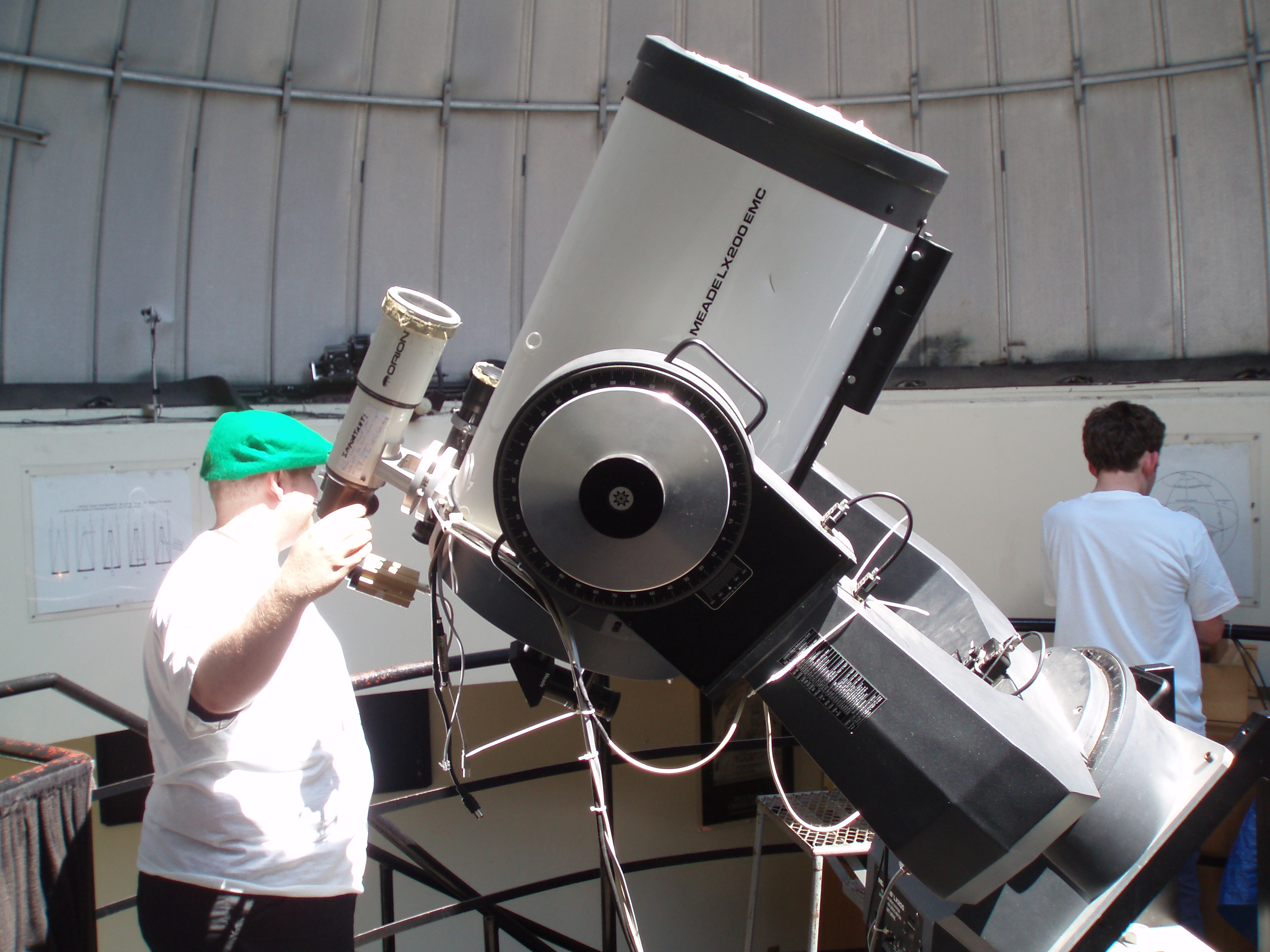|
Guillermo Haro Observatory
The Guillermo Haro Observatory (Spanish: Observatorio Astrofísico Guillermo Haro - OAGH) is an astronomical observatory owned and operated by the National Institute of Astrophysics, Optics and Electronics (Spanish: Instituto Nacional de Astrofísica, Óptica y Electrónica - INAOE) in the Mexican state of Sonora. It is located north of Cananea and south-east of Mount Hopkins. It is named after Professor Guillermo Haro. Telescopes The main telescope at the observatory is Ritchey-Chretein design with a primary mirror and a secondary mirror. Four different instruments are available to be mounted at the Cassegrain focus. Planning for the telescope began in 1972, but it was not dedicated until 1987. Routine operations began in 1992. The observatory has a Schmidt-Cassegrain reflector built by Meade Instruments on an equatorial mount located in a separate dome. It is used to make atmospheric extinction measurements and to monitor light pollution. See also * National Ast ... [...More Info...] [...Related Items...] OR: [Wikipedia] [Google] [Baidu] |
National Institute Of Astrophysics, Optics And Electronics
The National Institute of Astrophysics, Optics and Electronics (in Spanish: ''Instituto Nacional de Astrofísica, Óptica y Electrónica, INAOE'') is a Mexican science research institute located in Tonantzintla, Puebla. Founded by presidential decree on November 12, 1971, it has over 100 researchers in Astrophysics, Optics, Electronics and Computing Science, with postgraduate programs in these areas. INAOE is one of 30 public research centers sponsored by the National Council of Science and Technology of Mexico (''CONACyT''). The Institute, in partnership with the University of Massachusetts Amherst, developed the Large Millimeter Telescope / Gran Telescopio Milimétrico on the Puebla-Veracruz border. The asteroid 14674 INAOE was named after this institute. Structure There are four departments with a number of research groups and laboratories: * Astrophysics (José Ramón Valdés Parra) ** Visible Astronomical Instrumentation Laboratory and of High Energies (Esperanza C ... [...More Info...] [...Related Items...] OR: [Wikipedia] [Google] [Baidu] |
Cassegrain Reflector
The Cassegrain reflector is a combination of a primary concave mirror and a secondary convex mirror, often used in optical telescopes and radio antennas, the main characteristic being that the optical path folds back onto itself, relative to the optical system's primary mirror entrance aperture. This design puts the focal point at a convenient location behind the primary mirror and the convex secondary adds a telephoto effect creating a much longer focal length in a mechanically short system. In a symmetrical Cassegrain both mirrors are aligned about the optical axis, and the primary mirror usually contains a hole in the center, thus permitting the light to reach an eyepiece, a camera, or an image sensor. Alternatively, as in many radio telescopes, the final focus may be in front of the primary. In an asymmetrical Cassegrain, the mirror(s) may be tilted to avoid obscuration of the primary or to avoid the need for a hole in the primary mirror (or both). The classic Cassegrain ... [...More Info...] [...Related Items...] OR: [Wikipedia] [Google] [Baidu] |
List Of Astronomical Observatories
This is a list of astronomical observatories ordered by name, along with initial dates of operation (where an accurate date is available) and location. The list also includes a final year of operation for many observatories that are no longer in operation. While other sciences, such as volcanology and meteorology, also use facilities called observatories for research and observations, this list is limited to observatories that are used to observe celestial objects. Astronomical observatories are mainly divided into four categories: space-based, airborne, ground-based, and underground-based. Many modern telescopes and observatories are located in space to observe astronomical objects in wavelengths of the electromagnetic spectrum that cannot penetrate the Earth's atmosphere (such as ultraviolet radiation, X-rays, and gamma rays) and are thus impossible to observe using ground-based telescopes. Being above the atmosphere, these space observatories can also avoid the effects of atmo ... [...More Info...] [...Related Items...] OR: [Wikipedia] [Google] [Baidu] |
National Astronomical Observatory (Mexico)
The National Astronomical Observatory (Spanish: ''Observatorio Astronómico Nacional''—OAN) is an astronomical observatory in Baja California, Mexico. History Mexico City The observatory was first established on the balcony of Chapultepec Castle in Mexico City in 1878. The observatory has been operated by the National Autonomous University of Mexico (UNAM) since 1929. It was later moved to Palacio del Ex-Arzobispado in Tacubaya, then on the outskirts of the city on the west side of the Federal District. The location is remembered by the name Metro Observatorio, the terminal station of the Line 1 of the Mexico City Metro located nearby. Puebla In the middle of the 20th century, OAN had to move from the increasingly crowded and polluted Valley of Mexico, to Tonantzintla in Puebla state, Central Mexico. Baja California In 1967 excessive air pollution and night light pollution caused another move, from Puebla to atop the Sierra San Pedro Mártir mountain range of Baja Cali ... [...More Info...] [...Related Items...] OR: [Wikipedia] [Google] [Baidu] |
Light Pollution
Light pollution is the presence of unwanted, inappropriate, or excessive use of artificial Visible spectrum, lighting. In a descriptive sense, the term ''light pollution'' refers to the effects of any poorly implemented lighting, during the day or night. Light pollution can be understood not only as a phenomenon resulting from a specific source or kind of pollution, but also as a contributor to the wider, collective impact of various sources of pollution. Although this type of pollution can exist throughout the day, its effects are magnified during the night with the contrast of darkness. It has been estimated that 83 percent of the world's people live under light-polluted skies and that 23 percent of the world's land area is affected by skyglow. The area affected by artificial illumination continues to increase. A major side-effect of urbanization, light pollution is blamed for compromising health, disrupting ecosystems, and spoiling aesthetic environments. Globally, it has incr ... [...More Info...] [...Related Items...] OR: [Wikipedia] [Google] [Baidu] |
Atmospheric Extinction
In astronomy, extinction is the absorption and scattering of electromagnetic radiation by dust and gas between an emitting astronomical object and the observer. Interstellar extinction was first documented as such in 1930 by Robert Julius Trumpler. However, its effects had been noted in 1847 by Friedrich Georg Wilhelm von Struve, and its effect on the colors of stars had been observed by a number of individuals who did not connect it with the general presence of galactic dust. For stars that lie near the plane of the Milky Way and are within a few thousand parsecs of the Earth, extinction in the visual band of frequencies (photometric system) is roughly 1.8 magnitudes per kiloparsec. For Earth-bound observers, extinction arises both from the interstellar medium (ISM) and the Earth's atmosphere; it may also arise from circumstellar dust around an observed object. Strong extinction in earth's atmosphere of some wavelength regions (such as X-ray, ultraviolet, and infra ... [...More Info...] [...Related Items...] OR: [Wikipedia] [Google] [Baidu] |
Meade Instruments
The Meade Instruments (also shortened to Meade) is an American multinational company headquartered in Watsonville, California, that manufactures, imports, and distributes telescopes, binoculars, spotting scopes, microscopes, CCD cameras, and telescope accessories for the consumer market. It is the world's largest manufacturer of telescopes. Besides selling under its "Meade" brand name, the company sells solar telescopes under the brand "Coronado". Origins and history Founded in 1972 by John Diebel, Meade started as a mail order seller of small refracting telescopes and telescope accessories manufactured by the Japan-based Towa Optical Manufacturing Company. Meade started manufacturing its own line of products in 1976, introducing 6" and 8" reflecting telescopes models in 1977. In 1980, the company ventured into the Schmidt-Cassegrain market that up to that time had been dominated by Celestron Corporation. Meade has a long history of litigation with other companies over infri ... [...More Info...] [...Related Items...] OR: [Wikipedia] [Google] [Baidu] |
Schmidt–Cassegrain Telescope
The Schmidt–Cassegrain is a catadioptric telescope that combines a Cassegrain reflector's optical path with a Schmidt corrector plate to make a compact astronomical instrument that uses simple spherical surfaces. Invention and design The American astronomer and lens designer James Gilbert Baker first proposed a Cassegrain design for Bernhard Schmidt's Schmidt camera in 1940. The optical shop at Mount Wilson Observatory manufactured the first one during World War II as part of their research into optical designs for the military. As in the Schmidt camera, this design uses a spherical primary mirror and a Schmidt corrector plate to correct for spherical aberration. In this Cassegrain configuration the convex secondary mirror acts as a field flattener and relays the image through the perforated primary mirror to a final focal plane located behind the primary. Some designs include additional optical elements (such as field flatteners) near the focal plane. The first large tele ... [...More Info...] [...Related Items...] OR: [Wikipedia] [Google] [Baidu] |
Ritchey–Chrétien Telescope
A Ritchey–Chrétien telescope (RCT or simply RC) is a specialized variant of the Cassegrain telescope that has a hyperbolic primary mirror and a hyperbolic secondary mirror designed to eliminate off-axis optical errors (coma). The RCT has a wider field of view free of optical errors compared to a more traditional reflecting telescope configuration. Since the mid 20th century, a majority of large professional research telescopes have been Ritchey–Chrétien configurations; some well-known examples are the Hubble Space Telescope, the Keck telescopes and the ESO Very Large Telescope. History The Ritchey–Chrétien telescope was invented in the early 1910s by American astronomer George Willis Ritchey and French astronomer Henri Chrétien. Ritchey constructed the first successful RCT, which had an aperture diameter of in 1927 (e.g. Ritchey 24-inch reflector). The second RCT was a instrument constructed by Ritchey for the United States Naval Observatory; that telescope is st ... [...More Info...] [...Related Items...] OR: [Wikipedia] [Google] [Baidu] |
Cananea
Cananea is a city in the Mexican state of Sonora, Northwestern Mexico. It is the seat of the Municipality of Cananea, in the vicinity of the U.S−Mexico border. The population of the city was 31,560 as recorded by the 2010 census. The population of the municipality, which includes rural areas, was 32,936. The total area of the municipality is approximately . History The first non-indigenous inhabitants of the present day Cananea, arrived in 1760 from other parts of the Spanish Viceroyalty of New Spain (colonial México). In the 19th century General Ignacio Pesqueira, from nearby Arizpe, retired to Cananea. He fought against the Apache who raided the area. One time, while following them into the mountains, he discovered the abandoned Spanish mines and by 1868 he had renewed the extraction of minerals in the Cananea mines. General Pesqueira's wife, Elena Pesqueira Pesqueira, "discovered" a nearby mountain range (''sierra'') and the General named the highest peak ''La Elen ... [...More Info...] [...Related Items...] OR: [Wikipedia] [Google] [Baidu] |
Guillermo Haro
Guillermo Haro Barraza (; 21 March 1913 – 26 April 1988) was a Mexican astronomer. Through his own astronomical research and the formation of new institutions, Haro was influential in the development of modern observational astronomy in Mexico. Internationally, he is best known for his contribution to the discovery of Herbig–Haro objects. Early life was born in Mexico City on 21 March 1913 to Ignacio Haro and Leonor Barraza. He studied philosophy and law at the National Autonomous University of Mexico (UNAM). While working as a reporter for ''Excélsior'', Haro became interested in astronomy after a 1937 interview with Luis Enrique Erro. As a result of his dedication and enthusiasm for astronomy, he was hired by Erro in 1943 as an assistant at the newly founded Observatorio Astrofísico de Tonantzintla. Erro arranged for Haro to further his astronomical training in the United States at the Harvard College Observatory, Case Observatory (1944), Yerkes Observatory and M ... [...More Info...] [...Related Items...] OR: [Wikipedia] [Google] [Baidu] |







